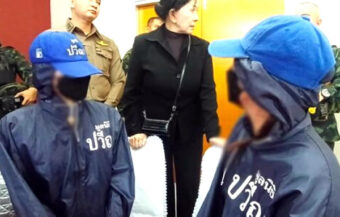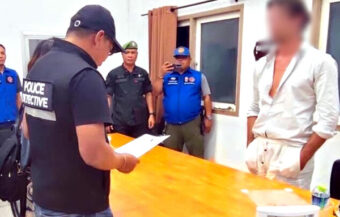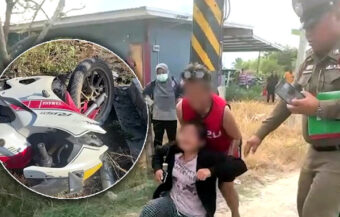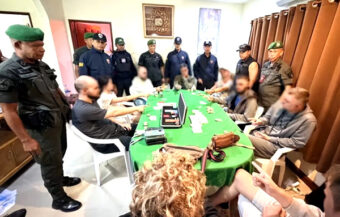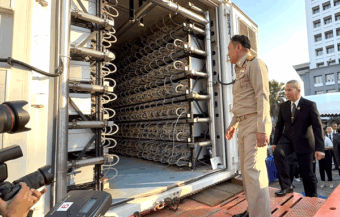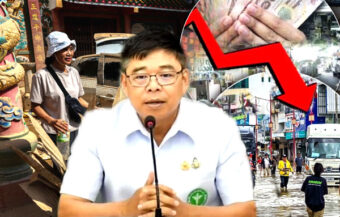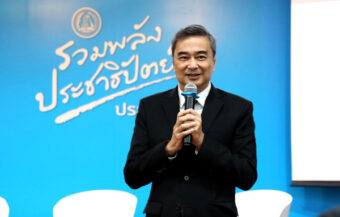Thailand warns Cambodia over deployment of Chinese-made long-range PHL-03 missiles near the border after deadly attacks on civilians. Thai military vows to target missile systems threatening security, with tensions escalating amid cross-border strikes and a growing risk of wider conflict.
Despite battlefield gains on Saturday, top Thai military officials are raising alarm over a growing threat from Cambodia. Major General Wanchana Sawasdee, Director of Security Mission Coordination, warned that Cambodia has moved its Chinese-made PHL-03 missile launchers dangerously close to the Thai border. In response, Thailand is making it clear: if those systems threaten civilians, they will be taken out.
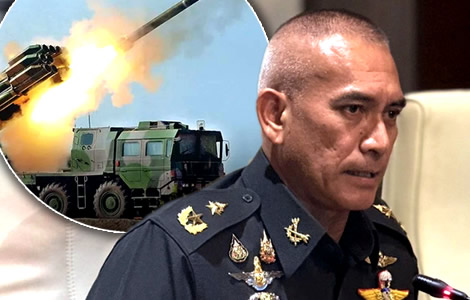
Military hostilities between Thailand and Cambodia have escalated dramatically following a deadly cross-border attack and rising concerns over missile deployments. On Thursday, Cambodia launched a salvo of rockets and missiles into Thai territory, striking civilian areas and killing 13 people. Several others were injured. Among the targets were hospitals, schools and fuel stations in provinces near the border.
In response, Thailand’s military leadership has issued a stark warning. Officials believe Cambodia has moved Chinese-made long-range missile systems—the PHL-03—closer to the Thai border. This missile system, they say, could pose a serious threat to national security and civilian lives.
Military warns of Chinese-made PHL-03 missile systems deployed dangerously close to Thailand’s border
According to Major General Wanchana Sawasdee, Director of Security Mission Coordination at the Internal Security Operations Command, the situation has reached a critical stage. “The movement of the PHL-03 is a clear threat,” he said on Saturday. “If Thailand uses deep destruction, it is justified and proportionate.”
The PHL-03 is a highly capable Chinese multiple launch rocket system. It fires twelve 300mm rockets from a mobile 8×8 wheeled vehicle. The missiles have a maximum range of 130 kilometres, which puts nine Thai provinces within direct reach from Cambodian launch positions. These provinces include Ubon Ratchathani, Si Sa Ket, Surin, Buriram, Nakhon Ratchasima, Sa Kaeo, Chachoengsao, Chanthaburi and Trat.
Notably, if fired simultaneously, a full PHL-03 salvo can cover 420 rai of land—about 670,000 square meters. That’s nearly the size of eight football fields. The warheads used vary in type. Unguided munitions include BRC3 and BRC4 cluster warheads. High-explosive variants, such as the BTE2, are also available. Additionally, the system can fire precision-guided rockets such as the BRE3 or FD140A.
PHL-03 rocket system is a strategic asset with high mobility and a range threatening Thai urban centres
Therefore, Thai analysts warn the PHL-03 is not just a tactical weapon. It is a strategic asset that could alter the military balance in the region. Its rapid mobility—travelling at 60 km/h with a range of 650 km—makes it difficult to track and destroy once deployed.
Meanwhile, the Thai Second Army Region has activated its Rear Area Defence Plan. Troops along the eastern border have been placed on high alert. Intelligence reports confirm that Cambodia has concentrated military units along the frontier and moved heavy weaponry.
As a precaution, the Thai military has advised civilians in high-risk areas to stay alert and follow official updates. While they urge the public not to panic, officials admit that the missile threat is very real. “This is not a drill,” said one Thai officer. “We are dealing with a credible, mobile and destructive weapon system.”
Thailand’s air operations have already begun in limited form. According to Maj. Gen. Wanchana, Thai strikes have focused strictly on Cambodian military infrastructure. “We are not using excessive force,” he said. “Our targets are precise and exclusively military.”
Thai troops placed on high alert as limited air strikes target Cambodian military infrastructure threats
Despite Thailand’s justification, Cambodian officials strongly deny the allegations. On Saturday, Lieutenant General Mali Socheata, spokesperson for the Cambodian Defence Forces, issued a firm statement from Phnom Penh. “Cambodia has no need to use the PHL-03,” she said. “The claims are false and aimed at misleading the public.”
She insisted that no long-range weapons had been deployed near the border. According to Lt. Gen. Mali, the Thai government was spreading misinformation to justify aggressive action and damage Cambodia’s credibility. “We are not the aggressors,” she added. “We seek stability, not escalation.”
However, satellite images and military intelligence tell a different story. According to Thai sources, several truck-mounted launch systems have been observed in forested regions near the border. These mobile units, believed to be PHL-03 batteries, are within striking distance of Thai population centres.
Therefore, Thai defence analysts believe Cambodia is preparing for potential large-scale bombardment. This, they argue, explains Thailand’s recent air raids, which struck supply routes and ammunition depots on the Cambodian side.
Cambodia denies PHL-03 missile deployment as Thai intelligence confirms launch systems near border
Additionally, the Thai government argues that its air operations are in direct response to three Cambodian actions: the concentration of troops, attacks on Thai civilians and the deployment of strategic weapons.
According to military sources, Cambodia’s initial missile attacks were not accidental. Several Thai towns were deliberately targeted. One strike reportedly destroyed a rural hospital in Si Sa Ket, while another hit a school in Surin. Fuel depots and civilian homes were also damaged, leading to power outages and mass evacuations.
As a result, Thailand’s political leadership has backed the military response. Defence planners have also warned that further aggression from Cambodia will result in stronger retaliatory strikes. Some Thai officials have even hinted at ground operations if the PHL-03 systems remain in place.
Meanwhile, experts warn that Cambodia may face more than just military losses. “If Cambodia cannot find a way to end this conflict,” said a senior Thai analyst, “its armed forces and long-term defence capability will suffer irreversible damage.”
Thai government justifies air strikes citing Cambodian troop buildup, missile attacks, and threats to civilians
So far, Cambodia has shown no willingness to pull back its missile units. The country’s Ministry of Defence continues to deny its presence entirely. This denial has frustrated Thai officials, who say the threat is both visible and verified.
Still, Thailand maintains that its primary goal is de-escalation. Officials emphasise that current military actions are aimed at neutralising threats, not prolonging conflict. “We want to prevent more civilian deaths,” said Maj. Gen. Wanchana. “That is our mission.”
In the meantime, international observers have called for calm. Although ASEAN has not made a formal intervention, diplomatic back channels are reportedly active. Several regional governments have expressed concern over the risk of a broader conflict.
If no progress is made, Southeast Asia may be facing one of its most serious military stand-offs in recent decades. The use of high-capacity long-range missile systems in densely populated zones raises the stakes dramatically.
Despite Cambodia’s denials, Thailand seeks de-escalation amid risk of a serious regional military stand-off
For now, the situation remains fluid. Thai forces are watching for any movement from Cambodia’s missile units. They have also increased aerial patrols and deployed drones to monitor border areas.
Officials in Bangkok are expected to hold an emergency national security meeting in the coming days. Military planners are preparing several response scenarios, including expanded air campaigns and joint operations with allied units.
Hot War rages on the Thai Cambodian border with Cambodian troops on the offensive in Chong Bok area
Cambodia’s Hun Sen’s hidden agenda for unprovoked, deadly and destructive actions may involve China
14 killed and over 100,000 evacuated as army brings in more guns trained on Cambodian border forces
Thai border sealed and citizens in Cambodia urged to get home as war rages in deadly cross-border fire
What happens next may depend on Cambodia’s decision. If it continues to deny and delay, Thailand has made it clear it will act unilaterally to eliminate the threat.
Join the Thai News forum, follow Thai Examiner on Facebook here
Receive all our stories as they come out on Telegram here
Follow Thai Examiner here
Further reading:
Hot War rages on the Thai Cambodian border with Cambodian troops on the offensive in Chong Bok area
14 killed and over 100,000 evacuated as army brings in more guns trained on Cambodian border forces
Military blasts Cambodia for breaching international law by planting mines which injured 3 soldiers
Dangerous impasse between Thailand and Cambodia as PM rules out International Court of Justice (ICJ)
Hun Manet confirms Cambodia ultimately may decide to send border dispute with Thailand to the Hague
Khmer soldier killed in deadly gunfire between Thai and Cambodian armies near Ubon Ratchathani

